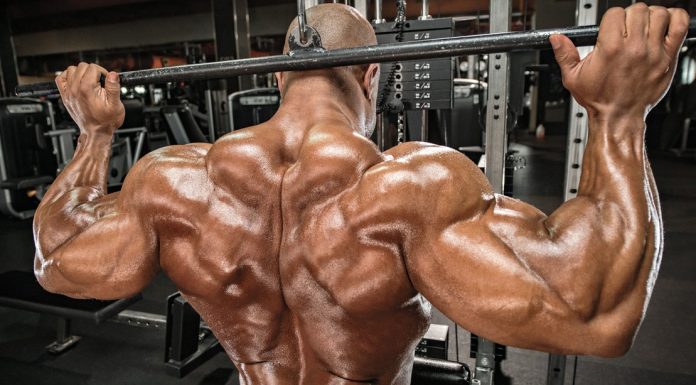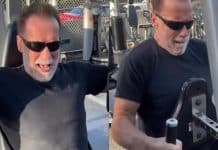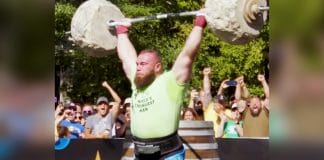
These are the 10 best back exercises to add mass to your physique and widen your frame.
Your back muscles play a crucial role in everyday life. A strong back helps you walk and keep a good posture. Plus, it’s critical to build an aesthetically pleasing physique. Bodybuilders train their backs hard with a lot of volume. That’s because your back broadens your frame and stands out on stage during bodybuilding contests. Below are the 10 best back exercises bodybuilders do and how to perform them.
Best Back Exercises
- Barbell Deadlift
- Sumo Deadlift
- Pendlay Row
- Close Grip Lat Pulldown (V-Bar)
- Landmine Row
- Lat Pulldown (Wide-Grip)
- Barbell Bent-Over Row
- Dumbbell Bent-Over Row (Single-Arm)
- Pull-Up
- Seated Cable Row (V-Bar)
Barbell Deadlift
The barbell deadlift is one of the “big three” compound movements (barbell deadlift, barbell squat, and barbell bench press), and it’s a great indicator of your overall strength. This exercise allows you to use heavy weight and the most weight of the big three. It targets your back and hamstrings and is considered to have the highest muscle activation of your spinal erector muscles compared to other exercises (1).
Benefits of the Deadlift
- The barbell deadlift allows you to use heavy weights to target your upper and lower body.
- It’s one of the “big three” movements and a great way to measure your overall strength.
How to Do the Deadlift
Get into a shoulder-width stance in front of a loaded barbell on the ground. Hinge your hips and squat down to grab the barbell about shoulder-width apart. Keep your back straight, especially your lower back, shoulders retracted, and head and chest up. Extend your hips and “slide” the barbell up your shins until you stand upright. That counts as one rep.
Sumo Deadlift
The sumo deadlift is similar to the deadlift, except it’s performed with a wider stance. It still targets your back, but the wider stance puts a larger emphasis your adductor muscles and is easier on your back.
Benefits of the Sumo Deadlift
- This exercise targets your adductors more than conventional deadlifts.
- Sumo deadlifts don’t place as much tension on your back as conventional deadlifts.
How to Do the Sumo Deadlift
Get into a wide stance with your toes pointed out. With your back upright, hinge your hips and squat down to grasp the barbell with a shoulder-width grip. Extend your hips and pull the weight up until your hips are fully extended. Then, lower the weight back to the floor.
The Pendlay Row
The Pendlay row is similar to the barbell bent-over row, and the difference is that the Penlday row allows you to rest the barbell on the ground briefly after each rep. This will enable you to use more weight and place less tension on your back.
Benefits of the Pendlay Row
- This exercise places less stress on your back compared to the barbell-bent-over row.
- This movement lets you use more weight compared to other rows.
How to Do the Pendlay Row
While in a shoulder-width stance, hinge until your torso is almost parallel with the ground. And grab a barbell from the ground. Explosively row the barbell towards your stomach, then lower the barbell down to the ground.
Close Grip Lat Pulldown (V-Bar)
As the name suggests, the close grip lat pulldown is performed on the lat pulldown machine, except with a V-bar double grip attachment. The V-bar double grip attachment will force you to use a closer grip to target more of your biceps and mid-back rather than entirely on your lats.
Benefits of the Close Grip Lat Pulldown
- It targets your mid-back and biceps.
- The cable machine keeps constant tension on your back and biceps.
How to Do the Close Grip Lat Pulldown
Attach a V-bar double grip to the cable lat pulldown machine. Adjust the leg padding on your thighs until your legs are comfortably secured. Grasp the V-bar and pull it to your upper chest, then extend the cable back up.
Landmine Row
The landmine (T-bar) row is a tremendous alternative rowing movement that adds variety to your back exercises to engage your back muscles and core. It’s good for grip strength and allows you to use different attachments, and it was a favorite back exercise of of 7x Mr. Olympia winner, Arnold Schwarzenegger.
Benefits of the Landmine Row
- It adds variety to your rowing exercises to target different areas of your back and core.
- This exercise strengthens your grip strength and enables you to use various attachments.
How to Do the Landmine Row
Slide a barbell in a landmine sleeve attachment. Place one foot on either side of the barbell and grab the barbell (or attachment) while in a hip-hinge bent-over position of about 45 degrees. Row the weight to your chest, then extend your arms back down.
Lat Pulldown (Wide-Grip)
The lat pulldown is a classic back exercise performed on a cable with a wide grip bar to target your upper lats. This movement is excellent for people who can’t do pull-ups. Its constant tension helps you grow your outer back muscles.
Benefits of the Lat Pulldown
- The lat pulldown is an excellent replacement for pull-ups.
- This exercise keeps constant tension on your upper lats.
How to Do the Lat Pulldown
Set up on a lat pulldown machine with your thighs secured comfortably under the padding and grasp the wide bar with a wide grip (farther than shoulder-width) with a pronated grip (palms facing away from you). Pull the bar down to your chest without swinging, then slowly extend your arms to the starting position.
Barbell Bent-Over Row
Besides deadlift, this is one of the best movements you can do for your back, something to really add muscle mass. The barbell bent-over row enables you to load a barbell with heavy weight to activate your back muscles significantly, including your lats, upper back, and lower back.
Benefits of the Barbell Bent-Over Row
- It allows you to use heavy weights.
- This exercise stimulates many back muscles.
How to Do the Barbell Bent-Over Row
Load up a barbell with plates on both sides on the ground–or you can set this exercise up on safety handles in a rack, so you don’t have to pick the barbell up from the ground. Grab the barbell slightly wider than a shoulder-width grip, hinge your hips about 45 degrees with your arms extended, then row the barbell to your stomach. That’s one rep.
Single Arm Dumbbell Row
The dumbbell row is different than the barbell bent-over row because not only do you use dumbbells, of course. But you also perform this exercise on a bench, a unilateral (single-limb) movement. Targeting one side at a time will correct muscle imbalances and give you a better mind-muscle connection. Moreover, it will activate more of your core muscles (2).
Benefits of the Dumbbell Row
- The dumbbell row is a unilateral exercise that engages your core, improves your mind-muscle connection, and corrects muscular imbalances.
- It’s easier on your lower back compared to the barbell bent-over row.
How to Do the Dumbbell Bent-Over Row
Grab a single dumbbell and place one knee and arm (same side) on a flat bench with your other leg extended and planted on the ground for support.
Relax your head and neck, look down, keep your back straight and shoulders retracted, then row the dumbbell up.
Pull-Up
The pull-up is one of the most strenuous back exercises you can do, and it requires very little equipment. It targets your lats and requires you to pull your entire body weight. Plus, you can attach weights to your body via a belt to target your upper back muscles even more. Moreover, they engage your core and shoulders.
Benefits of the Pull-Up
- The pull-up builds excellent relative strength (strength for your body weight).
- It allows you to add weight to your body to target your lats more.
- This exercise engages your core and shoulders.
How to Do the Pull-Up
You’ll grab a pull-up bar with a wide (wider than shoulder-width) pronated grip and hang without your feet touching the ground. Then, you’ll pull yourself up until you feel the contraction in your back and your shoulders and chin are over the bar.
Seated Cable Row
The seated cable row targets more of your mid back and trapezius, and it’s performed on a cable machine with a V-bar double-grip attachment. Additionally, the closer grip allows you to target more of your mid-back.
Benefits of Seated Cable Row
- This movement targets your mid-back.
- This exercise increases shoulder flexibility and posterior strength.
How to Do the Seated Cable Row
Sit comfortably on the cable seated machine with your feet slightly bent on the foot platform. And lean forward to grab the V-bar double-grip attachment. Next, lean back and keep your back upright with your arms extended while limiting momentum; row the V-bar towards your chest.
Benefits of the Best Back Exercises
Your back is composed of essential muscles–lats, erector spinae, and rhomboids–that play a vital role in keeping your frame together. Without solid back muscles, walking and standing upright would be difficult. So it’s imperative for good posture (3).
A broad back increases your overall strength and mass since your lats are a big muscle. Moreover, a strong back prevents chest injuries since they are antagonist muscles, meaning one lengthens as the other contracts. A wider back will also improve your waist-to-hip ratio since it will broaden your physique, giving you a better V-shape.
How to Train Your Back
Training your back differs from working out its anterior brother, the chest. That’s because the back is composed of many more muscles than your chest, so you have to do a variety of movements to target different angles of your back.
So you’ll want to include a mix of movements that target your upper lats, lower lats, upper middle back, lower middle back, and lower back. For example, cable wide-grip lat pulldown will mostly engage your upper lats. And cable seated row with a double-grip attachment will engage more of your middle back.
It’s best to start with bilateral (multi-joint) compound movements such as barbell bent-over row or Pendlay rows before doing unilateral (single-limb) exercises like dumbbell bent-over row. That’s because you want to focus on the movements that allow you to use the most weight to start your workout–which is where the bulk of your muscle growth will come from. Then, transition to accessory movements to add volume to your back for additional muscle growth.
For a combination of strength and muscle mass, it’s best to perform reps in the 8-12 rep range. Your weight training level (beginner, intermediate, advanced) will determine how many sets you should perform. Beginners should start with two sets, intermediate lifters can perform three, and advanced lifters can perform up to five. Also, the more advanced you are, the more back exercises you can do per workout. For example, a beginner may only perform 3-4 exercises, while a bodybuilder may do six.
Common Mistakes of the Best Back Exercises
Since your back is vital for everyday life and gait, you should take extra precautions to protect your back. Avoid these common mistakes below when performing back exercises.
Rounding Your Back
Rounding your back during back movements will increase your chance of injury. So you must keep your back straight during exercises.
Not Targeting the Different Muscles in Your Back
Your back is composed of many muscles, so you mustn’t just target your upper lats, for example, from pull-ups and wide-grip cable lat pulldowns. Instead, throw in other movements that target different areas of your back, such as close grip lat pulldown and cable seated rows to target more of your mid-back and trapezius.
Using the Same Grip
It would be best if you used various grips on movements to target other areas of your back. For example, on wide grip cable lat pulldown, you can switch from a pronated grip to a reverse grip (palms facing towards you)—a reverse grip targets more secondary muscle groups during pulling movements to hit your middle back and biceps.
Stretching and Warm Up
Stretching and warming up are key parts of a smart back workout plan. Both will prevent injury. And warming up will prime your body for back movements to increase your workout performance. Understanding the importance between dynamic and static stretching will improve your range of motion to contract more of your back muscles on exercises.
Warm Up
The best way to warm up your back before a workout is to perform a couple of sets with light weights on a big compound movement such as barbell bent-over row or cable lat pulldown. Start with light weight and work your way up to heavier weight without fatiguing your muscles before your workout.
Stretching
The best way to stretch your back is to perform a static (non-movement) stretch after your workout. Kneel on the ground in front of a bench and lie your arms across a flat bench; your torso and arms should be parallel to the floor, and you’ll feel a deep lat stretch. Hold this position for 10-30 seconds.
Best Back Exercises Wrap Up
These are hands down the best back exercises you can add to your pulling routine. Do you agree with our list?
Here are other back workouts you can try to add variety to your back workouts:
References
- Fischer, S. C., Calley, D. Q., & Hollman, J. H. (2021). Effect of an Exercise Program That Includes Deadlifts on Low Back Pain. Journal of sport rehabilitation, 30(4), 672–675. https://doi.org/10.1123/jsr.2020-0324
- Saeterbakken, A., Andersen, V., Brudeseth, A., Lund, H., & Fimland, M. S. (2015). The Effect of Performing Bi- and Unilateral Row Exercises on Core Muscle Activation. International journal of sports medicine, 36(11), 900–905. https://doi.org/10.1055/s-0034-1398646
- Henson B, Kadiyala B, Edens MA. Anatomy, Back, Muscles. [Updated 2021 Aug 10]. In: StatPearls [Internet]. Treasure Island (FL): StatPearls Publishing; 2022 Jan-. Available from: https://www.ncbi.nlm.nih.gov/books/NBK537074/















